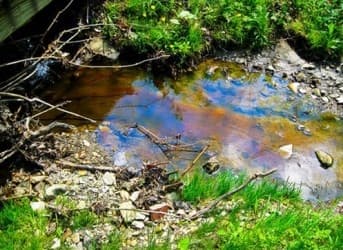The amount of wastewater from natural gas production in the Marcellus shale region has increased by about 570 percent since 2004 as a result of increased shale gas production there.
The scale of fracking operations in the region is so vast that the wastewater it produces threatens to overwhelm the region’s disposal capacity, according to new analysis by researchers at Duke and Kent State universities.
However, the analysis also shows that hydraulically fractured natural gas wells in the Marcellus shale region of Pennsylvania produce only about 35 percent as much wastewater per unit of gas recovered as conventional wells. The findings are reported in the journal Water Resources Research.
“We found that on average, shale gas wells produced about 10 times the amount of wastewater as conventional wells, but they also produced about 30 times more natural gas,” says Brian Lutz, assistant professor of biogeochemistry at Kent State, who led the study while he was a postdoctoral research associate at Duke University
Related Article: Why Shale Oil is not the Game Changer we Have Been Led to Believe - Part 2
“That surprised us, given the popular perception that hydraulic fracturing creates disproportionate amounts of wastewater.”
The findings, says Lutz, are a double-edged sword. “On one hand, shale gas production generates less wastewater per unit. On the other hand, because of the massive size of the Marcellus resource, the overall volume of water that now has to be transported and treated is immense.
“It threatens to overwhelm the region’s wastewater-disposal infrastructure capacity.”
“This is the reality of increasing domestic natural gas production,” says Martin Doyle, professor of river science at Duke’s Nicholas School of the Environment. “There are significant tradeoffs and environmental impacts whether you rely on conventional gas or shale gas.”
Briny water
The researchers analyzed gas production and wastewater generation for 2,189 gas wells in Pennsylvania, using publicly available data reported by industry to the state’s Department of Environmental Protection, in compliance with state law.
In hydraulic fracturing, large volumes of water, sand, and chemicals are injected deep underground into gas wells at high pressure to crack open shale rock and extract its embedded natural gas.
As the pace of shale gas production grows, so too have concerns about groundwater contamination and what to do with all the wastewater.
Related Article: Betting on Mediterranean Shale: 3 Plays, 1 Winner
Another surprise that emerged, Doyle says, was that well operators classified only about a third of the wastewater from Marcellus wells as flowback from hydraulic fracturing; most of it was classified as brine.
“A lot of attention, to date, has focused on chemicals in the flowback that comes out of a well following hydraulic fracturing,” he adds. “However, the amount of brine produced—which contains high levels of salts and other natural pollutants from shale rock—has received less attention even though it is no less important.”
Brine can be generated by wells over much longer periods of time than flowback, he notes, and studies have shown that some of the pollutants in brine can be as difficult to treat as many of the chemicals used in hydraulic fracturing fluids.
ADVERTISEMENT
“We need to come up with technological and logistical solutions to address these concerns, including better ways to recycle and treat the waste on site or move it to places where it can be safely disposed,” Doyle says. “Both of these are in fact developing rapidly.”
“Opponents have targeted hydraulic fracturing as posing heightened risks, but many of the same environmental challenges presented by shale gas production would exist if we were expanding conventional gas production,” Lutz adds. “We have to accept the reality that any effort to substantially boost domestic energy production will present environmental costs.”
The Marcellus shale formation stretches from New York to Virginia and accounts for about 10 percent of all natural gas produced in the United States today. Much of the current production is in Pennsylvania. Prior to technological advances in horizontal well drilling and hydraulic fracturing that made the shale gas accessible, the region accounted for only about 2 percent of the nation’s output.
Lutz and Doyle conducted their analysis with no external funding.
By. Tim Lucas


















